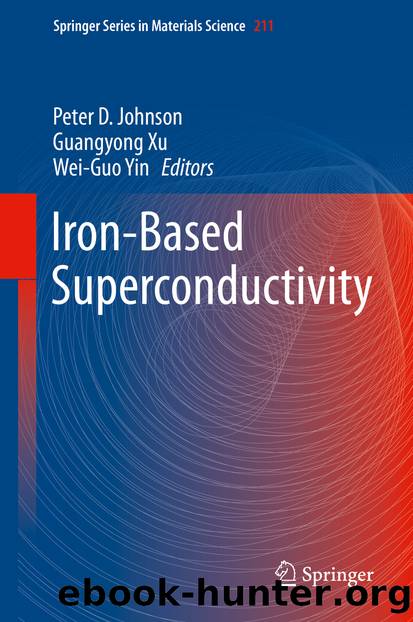Iron-Based Superconductivity by Peter D. Johnson Guangyong Xu & Wei-Guo Yin

Author:Peter D. Johnson, Guangyong Xu & Wei-Guo Yin
Language: eng
Format: epub
Publisher: Springer International Publishing, Cham
Figure 7.4 shows clearly that the anion bands within [ − 6, − 2] eV develop very strong shadows bands, of comparable intensity to the main bands. This reflects their strong coupling to the TSBP, as it is the alternating positioning of the anion that breaks the translational symmetry. Given that one can hardly distinguish the main bands from the shadow bands, it is obviously more convenient to consider these anion bands in the 2-Fe-atom Brillouin zone.
In great contrast, the Fe bands near the Fermi level have rather weak shadow bands. In fact, if it were not for the gap openings (some of which are quite large), the Fe bands would have looked just like those from a simple 5-band system. The overall weak intensity of shadow bands explains why neutron spectra appear to respect the 1-Fe-atom Brillouin zone: even though the real symmetry of the system dictates the 2-Fe-atom Brillouin zone, the folding of the spectrum is just not strong enough for a clear experimental identification. In fact, the lack of folded bands was also reported in a recent ARPES experiment [46]. Consequently, a larger 1-Fe-atom Brillouin zone is necessary in future ARPES measurements, since only about half of the EBSs are clearly observable in the 2-Fe BZ, where most ARPES to date were conducted.
Table 7.2Nearest-neighbor hopping integrals (in eV) along the x direction among Fe d Wannier orbitals for nonmagnetic
Download
This site does not store any files on its server. We only index and link to content provided by other sites. Please contact the content providers to delete copyright contents if any and email us, we'll remove relevant links or contents immediately.
| Automotive | Engineering |
| Transportation |
Whiskies Galore by Ian Buxton(41718)
Introduction to Aircraft Design (Cambridge Aerospace Series) by John P. Fielding(33016)
Small Unmanned Fixed-wing Aircraft Design by Andrew J. Keane Andras Sobester James P. Scanlan & András Sóbester & James P. Scanlan(32684)
Craft Beer for the Homebrewer by Michael Agnew(18081)
Turbulence by E. J. Noyes(7893)
The Complete Stick Figure Physics Tutorials by Allen Sarah(7264)
Kaplan MCAT General Chemistry Review by Kaplan(6822)
The Thirst by Nesbo Jo(6758)
Bad Blood by John Carreyrou(6476)
Modelling of Convective Heat and Mass Transfer in Rotating Flows by Igor V. Shevchuk(6353)
Learning SQL by Alan Beaulieu(6158)
Weapons of Math Destruction by Cathy O'Neil(6084)
Man-made Catastrophes and Risk Information Concealment by Dmitry Chernov & Didier Sornette(5877)
Digital Minimalism by Cal Newport;(5586)
Life 3.0: Being Human in the Age of Artificial Intelligence by Tegmark Max(5404)
iGen by Jean M. Twenge(5322)
Secrets of Antigravity Propulsion: Tesla, UFOs, and Classified Aerospace Technology by Ph.D. Paul A. Laviolette(5237)
Design of Trajectory Optimization Approach for Space Maneuver Vehicle Skip Entry Problems by Runqi Chai & Al Savvaris & Antonios Tsourdos & Senchun Chai(4957)
Electronic Devices & Circuits by Jacob Millman & Christos C. Halkias(4865)
